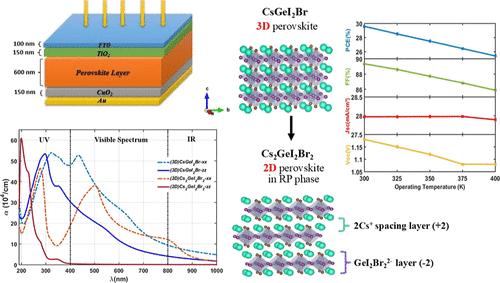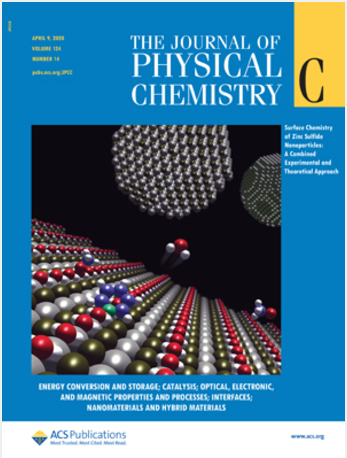通过研究 Ruddlesden-Popper (2D) Cs2GeI2Br2 和 (3D) CsGeI2Br 吸收体提高过氧化物太阳能电池的性能
IF 3.3
3区 化学
Q2 CHEMISTRY, PHYSICAL
引用次数: 0
摘要
Ruddlesden-Popper (RP) 包晶材料因其独特的结构和可调节的特性,在光电应用领域正日益受到重视。本研究探讨了 RP (2D) Cs2GeI2Br2 和 (3D) CsGeI2Br 吸收体在提高包晶体太阳能电池 (PSC) 性能方面的潜力。通过严谨的分析,我们发现集成 RP 相可以改善电荷传输并减少缺陷,从而提高器件性能。结果显示,直接带隙(2D 为 1.45 eV)、高光吸收(3D 为 50 × 104 cm-1 以上)、低反射率和能量损耗表明太阳能电池的适用性。计算得出的 Cs2GeI2Br2 有效质量值 (me*, mh*) (0.245, 0.423 eV) 与 Cs2PbI2Br2 和 Cs2PbI2Cl2 的有效质量值非常接近,表明这些材料中的电荷载流子行为相似。我们的研究为优化具有替代结构的 PSC 提供了宝贵的见解。此外,在标准 AM 1.5 G 太阳辐射条件下,使用 SCAPS-1D 软件模拟探索了各种空穴传输层和温度对关键电气参数的影响,在环境温度为 25 °C 时,PSC 原型的最高效率约为 29.59%。本文章由计算机程序翻译,如有差异,请以英文原文为准。

Enhancing Perovskite Solar Cells Performance Through Investigation of Ruddlesden–Popper (2D) Cs2GeI2Br2 and (3D) CsGeI2Br Absorbers
Ruddlesden–Popper (RP) perovskite materials are gaining traction in optoelectronic applications due to their unique structure and adjustable properties. This study investigates the potential of RP (2D) Cs2GeI2Br2 and (3D) CsGeI2Br absorbers in enhancing perovskite solar cell (PSC) performance. Through rigorous analysis, we find that integrating RP phases improves charge transport and reduces defects, leading to superior device performance. The results showed a direct bandgap (1.45 eV for 2D), high optical absorption (above 50 × 104 cm–1 for 3D), low reflectivity, and energy loss, indicating solar cell suitability. The calculated effective mass values (me*, mh*) (0.245, 0.423 eV) for Cs2GeI2Br2 closely resemble those reported for Cs2PbI2Br2 and Cs2PbI2Cl2, indicating similar charge carrier behavior in these materials. Our research provides valuable insights for optimizing PSCs with alternative structures. Additionally, simulations explore various hole transport layers and temperature effects on key electrical parameters under standard AM 1.5 G solar radiation using the SCAPS-1D software, achieving a maximum efficiency of approximately 29.59% for the PSC prototype at an ambient temperature of 25 °C.
求助全文
通过发布文献求助,成功后即可免费获取论文全文。
去求助
来源期刊

The Journal of Physical Chemistry C
化学-材料科学:综合
CiteScore
6.50
自引率
8.10%
发文量
2047
审稿时长
1.8 months
期刊介绍:
The Journal of Physical Chemistry A/B/C is devoted to reporting new and original experimental and theoretical basic research of interest to physical chemists, biophysical chemists, and chemical physicists.
 求助内容:
求助内容: 应助结果提醒方式:
应助结果提醒方式:


